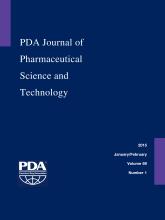Abstract
The primary container for parenterals is usually composed of glass. Given the recent industry-wide spike in glass-related problems, assays capable of detecting glass degradation before glass-related particles are visible in solution have practical significance. A rapid, high-throughput ion chromatography method coupled with molybdate reaction is described here for detection and quantitation of silicic acid (soluble form of silica) in complex samples. The method involves ion exchange separation of the silicate anion at high pH followed by a post-column derivatization step with sodium molybdate reagent. The resulting molybdo-silicate complex is detected with high sensitivity in the visible wavelength range at 410 nm and correlates to the level of soluble silica in solution. This assay is high-throughput and amenable for implementation during the early phase of product development. The assay provides a direct measurement to assess potential incompatibility between the formulation and its glass container. The Si levels measured by this method showed a direct correlation to the vial surface morphology changes as monitored by differential interference contrast microscopy.
LAY ABSTRACT: Recently, the pharmaceutical industry has been faced with glass quality challenges that have resulted in many products being recalled from the market. Monitoring levels of soluble silica in solution is critical because silica is the primary component of glass containers used in the pharmaceutical industry. Given this recent industry-wide increase in glass-related problems, assays capable of detecting glass degradation before glass-related particles are visible in solution have practical significance. A rapid assay to detect the soluble form of silica is presented here. The method presented will enable earlier detection of a formulation and container incompatibility instead of waiting until glass-related particles are visible in solution.
- Silicic acid
- Soluble silica
- Glass delamination
- Glass degradation
- Ion chromatography
- Formulation container incompatibility
- Molybdate
- Silico-molybdate complex
- Glass lamellae
- Glass dissolution
- © PDA, Inc. 2015
PDA members receive access to all articles published in the current year and previous volume year. Institutional subscribers received access to all content. Log in below to receive access to this article if you are either of these.
If you are neither or you are a PDA member trying to access an article outside of your membership license, then you must purchase access to this article (below). If you do not have a username or password for JPST, you will be required to create an account prior to purchasing.
Full issue PDFs are for PDA members only.
Note to pda.org users
The PDA and PDA bookstore websites (www.pda.org and www.pda.org/bookstore) are separate websites from the PDA JPST website. When you first join PDA, your initial UserID and Password are sent to HighWirePress to create your PDA JPST account. Subsequent UserrID and Password changes required at the PDA websites will not pass on to PDA JPST and vice versa. If you forget your PDA JPST UserID and/or Password, you can request help to retrieve UserID and reset Password below.






